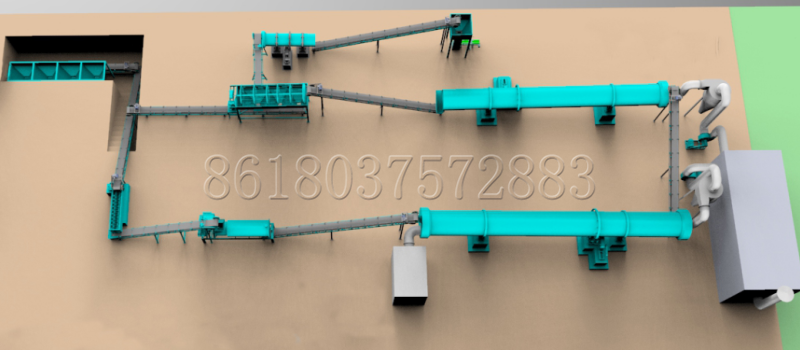
Cow dung organic fertilizer production line
The cow dung organic fertilizer production line is a complete set of equipment for processing organic fertilizer with cow manure as raw material. The cow manure processor can be used to first pump the cow manure from the manure tank to the equipment through the mud pump. After the equipment is dehydrated, the water content is 40%. %, you can also use crops such as straws and rice bran (including N\P\K) as fillers, and then sprinkle with biological inoculants, 1KG inoculants mixed with 20KG of water and moved into the raw materials, which can ferment 1 ton of raw materials. Turn and toss once every 1-2 days. Generally, it can be completely decomposed in 7-10 days.
In recent years, pollution of livestock and poultry manure and urine and residues of livestock and poultry products have caused problems to human health. The huge data of livestock and poultry production cannot fail to attract attention. If it is not handled properly, it will cause serious pollution to the environment. For example, because livestock and poultry manure is not treated in time, it will cause serious pollution to surface water, groundwater, soil and air. What’s more serious is that for the convenience of transportation, small-scale farmers simply piled up beef dung beside the road instead of adopting scientific storage methods. Due to neglect of management, wind and rain caused feces to flow everywhere. Such a situation is not conducive to animal epidemic prevention requirements, and it will certainly have a certain impact on people’s living environment.
The green ecological organic fertilizer is produced by fermenting cow dung and crop straw as the main raw materials and using multi-dimensional compound enzyme bacteria. The multi-dimensional compound enzyme bacteria is a microecological fermentation preparation composed of 106 beneficial microorganisms such as heat-resistant bacillus group, lactic acid group, bifidobacterium group, yeast group, etc., which can produce multiple enzymes. It is non-toxic, non-polluting to humans and animals. It is safe to use, can fix nitrogen, dissolve phosphorus, and potassium, and can decompose the residues of chemical pesticides and fertilizers. It has the effect of increasing production, high quality and disease resistance in the planting and breeding industries.
The organic fertilizer production line equipment has a compact process layout, scientific and reasonable, advanced technology, energy saving and consumption reduction, no three emissions, stable operation, reliable operation, convenient maintenance, and wide adaptability of raw materials. Adapt to various ratios of organic compound fertilizer, bio-organic fertilizer, municipal sludge, household waste organic fertilizer, etc. There are many kinds of organic fertilizers, the raw materials are very wide, and the fertilizers are also ever-changing.
There are many types of cow manure organic fertilizer production line in FPC. They all are sold at the favorable price. Welcome to our website for get the latest price of cow dung organic fertilizer production line. https://www.fertilizerplantcost.com/550000usd-organic-fertilizer-production-line-price/





